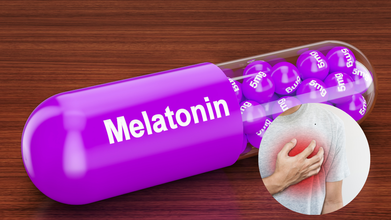- Health Conditions A-Z
- Health & Wellness
- Nutrition
- Fitness
- Health News
- Ayurveda
- Videos
- Medicine A-Z
- Parenting
- Web Stories
What Is Swimmer's Itch? How To Get Rid Of This Common Summertime Rash

Credit: Canva
Swimmer's itch is a rash caused by an allergic reaction to the larvae of microscopic parasites that are found in both fresh and saltwater. These parasites commonly live in snails, which secrete larvae into the water, per the CDC.
Swimming in contaminated water for even a short period of time can cause swimmer’s itch, and after you come in contact with the larvae, “when the skin dries off, those parasites burrow under people's skin and cause an itchy rash,” says Dr. Christina Boull, MD, an associate professor of dermatology and pediatrics at M Health Fairview University of Minnesota Medical Center. Read on to learn what symptoms to look out for and precautions you can take to prevent this uncomfortable summertime rash.
What Is Swimmer's Itch?
You can identify swimmer’s itch, also known as cercarial dermatitis, from the little red dots that appear on your skin after you’ve been exposed to the parasites, Boull says. The rash will likely manifest on skin that was directly exposed to the water as opposed to skin protected by your bathing suit. For this reason, your arms and legs are particularly vulnerable to swimmer’s itch, she says.
These dots typically appear 12 hours after exposure, and over the next day or two, some people may experience a more severe reaction with welts and blisters. “One of the main risk factors of complications from this rash would be a secondary bacterial infection.” If you scratch the rash, there’s a possibility of staph bacteria getting under your skin, leaving your body vulnerable to developing staph infections such as impetigo or cellulitis, she says.
What Can Be Mistaken For Swimmer's Itch?
When it comes to swimming in the ocean, seabather’s eruption is a rash that presents similar symptoms to swimmer’s itch. In terms of identifying whether your rash is swimmer’s itch or sea bather’s eruption, the latter tends to develop under a swimsuit, Boull explains. Comparatively, swimmer’s itch is more likely to appear in areas that are not protected by a swimsuit, she reiterates. Additionally, because swimmer’s itch presents as small red bumps, it is also commonly mistaken as bites caused by small bugs, such as gnats or mosquitoes, Boull says.
How Do You Get Rid Of Swimmer's Itch?
"The good news is that it spontaneously resolves," Boull says. Because people are the preferred hosts of the mites, they don’t live in the skin very long. Typically, the rash and itch significantly improve over the course of a week, although it's possible for it to last as long as three weeks, she says.
To quell the itching of the rash, Boull suggests 1% hydrocortisone, an over the counter topical steroid cream. She also recommends taking an oral antihistamine. In cases of severe itch, prescription oral prednisone and oral cortisone medicines can help relieve itch and inflammation.
If your swimmer’s itch has developed into blistering, open sores, and you’re experiencing fever, it could be signs of a secondary bacterial infection. In this case, it’s essential you see a doctor who can prescribe you oral antibiotics, Boull says.
Does Showering Kill Shower's Itchh?
The parasites that cause swimmer’s itch can only burrow into your skin after you’ve dried off. “So, it's really important after getting out of a lake or areas where you're swimming that would have snails, that you take a towel and really wipe the water off your skin.” Showering after you’ve gotten out of the water can also help prevent the parasites from getting underneath your skin.Does chlorine damage hair? Here’s how to protect your hair this swim season.
Snails tend to prefer warm, shallow water, so avoiding these areas can limit the possibility of exposure to the parasites. Finally, take note of no-swim zone signs that may indicate whether there are pathogens in the water.
Melatonin and Heart Failure: Could This “Natural” Sleep Supplement Be Causing Adverse Effects on Your Heart?

Credits: Canva
What's making headlines up recently is a new study, which yet has not been peer reviewed about how sleep medicine could have adverse affects on your cardiovascular health. Melatonin, which is a hormone produced naturally by the body to regulate the sleep-wake cycle, is also sold as dietary supplement, typically made synthetically, has been linked to causing heart failure.
The research is from an unpublished study that is set to be presented at the American Heart Association's scientific conference in New Orleans next week. The research notes that the sleep supplement could be linked to 90% increase in heart failure. This has drawn mixed reactions from sleep medicine experts and cardiologists. The experts have urged the public not to panic, and have called for more research into using melatonin for longer duration. Experts who have reviewed the study have noted for the limitations, which has made it challenging to determine whether and how long-term use of the sleep supplement could lead to heart failure. This happens when your heart is not pumping as well as it should.
As per Muhammad Rishi, an associate professor of clinical medicine and spokesperson for the American Academy of Sleep Medicine, "The findings are certainly provocative and warrant attention, especially given the widespread perception of melatonin as a benign, ‘natural’ sleep aid. However, the study is observational and based on electronic health record data, which limits its ability to establish causality."
What Is The Relation Between Melatonin And Heart?
Melatonin is secreted by brain's pineal gland in the evening, and it signals the body for sleep time. However, there are doctors who do not recommend using the supplement to treat chronic insomnia, reports the Washington Post. The reason being that the evidence for its efficacy is limited and inconsistent. The experts note that there is lack of data on its long-term usage.
In the US, melatonin does not require any prescription, however, experts have pointed out that it can only help people to treat sleep-timing problems due to jet lag or shift work, on low doses. Without being prescribed, these medicines could be procured over-the-counter, and could be used to treat chronic sleep disorders without proper guidance.
The new study that analyzed the international database of health records from five years of over 130,000 adults diagnosed with insomnia was able to recognize 65,000 participants who had been prescribed the supplement at least once for one year. The study noted that over the course of five years, around 3,000 people who took had melatonin experienced heart failure.
People who had already been diagnosed with heart failure, or were prescribed other sleep medicines, were excluded from the study.
The patients who took melatonin, were then compared with the ones who did not have melatonin, but had insomnia. The researchers found that this comparison allowed them to account for a variety of factors that could link a person's risk for heart failure, including other health conditions.
Ekenedilichukwu Nnadi, the lead author of the new report and chief resident in internal medicine at SUNY Downstate/Kings County Primary Care in Brooklyn, said, "What stood out most was that we found any association at all."
Nnadi said, "Melatonin is generally viewed as a very safe supplement, as something people, and even physicians, don’t usually worry much about, so we honestly didn’t expect to see a clear signal linking long-term use with higher rates of heart failure, hospitalizations and death.” However, the lead author did emphasize that the findings only showed association and not causation.
He said that the study does not prove that melatonin directly causes heart failure. “It simply shows that people with chronic insomnia who took melatonin long term were more likely to experience these outcomes. It’s an unexpected and important signal that needs to be studied further, ideally in randomized trials.”
Paracetamol Should Not Be Mixed With These Medications, Doctors Advise

Credits: Canva
The NHS has issued a warning for anyone using a common painkiller, highlighting possible harmful interactions with other medications. Across the UK, many people turn to over-the-counter medicines for daily aches, colds, and minor illnesses. Among these, paracetamol is one of the most widely used, often taken for headaches, back pain, and cold symptoms. But, like any medication, it carries certain risks.
Who Should Be Careful?
The NHS has provided guidance on using paracetamol safely, including which drug combinations should be avoided. “Paracetamol is not suitable for some people,” the health body explains. This includes individuals who take warfarin, a drug that prevents blood clots. If you are on warfarin, you should check with your GP before taking paracetamol, the NHS advises. “Paracetamol can raise the risk of bleeding in those who regularly take warfarin.”
Safe Dosing Guidelines
Small doses of paracetamol alongside warfarin are generally considered safe. The NHS adds: “It’s safe to take paracetamol if you’re on warfarin. Stick to the lowest dose that relieves your pain. Exceeding four 500mg tablets in 24 hours for more than a few days can slow your blood clotting, putting you at risk of bleeding.”
Avoid Double Dosing
Combining paracetamol with other medicines containing the same ingredient—like co-codamol or some cold and flu remedies—can be risky due to the danger of overdose. Other common painkillers, such as ibuprofen, aspirin, or codeine, do not contain paracetamol and can safely be taken at the same time.
Check with Your Doctor
The NHS advises consulting a doctor before taking paracetamol if you’re on medications for epilepsy or tuberculosis (TB), as these combinations can also pose risks.
Herbal Remedies and Supplements
Generally, paracetamol is not affected by herbal supplements, though the NHS notes: “There isn’t enough information to say whether herbal remedies, complementary medicines, or supplements are safe with paracetamol. They are not tested the same way as prescription or pharmacy medications and may interact differently.” Patients should inform their doctor or pharmacist about any other medicines or supplements they are taking.
Side Effects of Paracetamol
When taken at the recommended dose, paracetamol “very rarely” causes side effects. For a full list, refer to the information leaflet inside the packaging.
Serious Allergic Reactions
In rare cases, a serious allergic reaction (anaphylaxis) can occur. The NHS advises calling 999 immediately if you notice:
- Swelling of lips, mouth, throat, or tongue
- Rapid or labored breathing, wheezing, or a choking sensation
- A tight throat or difficulty swallowing
- Skin, lips, or tongue turning blue, grey, or pale (on darker skin, check palms or soles)
- Sudden confusion, extreme drowsiness, or dizziness
- Fainting and unresponsiveness
- A child appearing limp, floppy, or unresponsive, with difficulty lifting or focusing their head
Cancer Breakthrough: Researchers Pin Point The 'Big Bang' Moment Of The Tumor, Here's How

(Credit-Canva)
Colorectal cancer is one of the leading causes of cancer related death, according to the American Cancer Society. They state that colorectal cancer deaths in 2025 is expected to be 52,900. But why is the number so high, despite so many available treatments? One of the reasons behind it is the lack of early diagnosis.
However, with the help of a recent study that could completely change how we treat bowel cancer, also called colorectal cancer, scientists have found a moment very early on in the cancer life that they call the "Big Bang."
This moment is the key to understanding how the tumor grows and, most importantly, how it figures out how to hide from your body's immune system. Finding this hidden step gives doctors a new target for stopping cancer early and making existing powerful treatments work better.
Why is Cancer Difficult To Treat?
Bowel cancer is a significant problem, and while immunotherapy (which uses your own immune system to fight the disease) is a very promising treatment, it only works for a small number of people. This new research explains why the rest of the tumors are resistant. The “Big Bang” is the stage where the cancer cells essentially change their identity. They use complex biological tricks to stop showing the normal signs that would alert the immune system. This allows the cancer to secure its survival right from the start, dictating how dangerous it will be as it continues to grow.
How Do Cancer Cells Hide?
The main trick the cancer uses to hide is tied to something called neoantigens. Think of these as little "wanted" posters on the cancer cell's surface that tell the immune system, "Attack me!" The study found that cancer cells disrupt the creation of these posters. They do this using epigenetics. This doesn't involve changing the actual DNA code itself, but rather changing how the DNA is organized and read—like changing the font size or color of the book without changing the words. By making the part of the DNA that creates the "wanted" posters inaccessible, the cancer cells remove their disguise, effectively cloaking themselves and becoming invisible to your body's defenses.
Does Catching Colorectal Cancer Early Help?
The discovery that some bowel cancers essentially have this hidden evasion capability built in very early has massive implications for how doctors fight the disease. Experts like Professor Trevor Graham suggest that if doctors can treat the tumor right at or even before this “Big Bang” moment, they could make current treatments much more successful. This is also key for making cancer vaccines. Instead of just treating the existing tumor, these new vaccines could train your immune system to recognize and attack those "born-to-be-bad" cells before they can fully hide and cause the cancer to come back.
Is There A Better Way To Treat Colorectal Cancer?
This study was incredibly detailed because the scientists combined multiple high-tech ways of looking at the cancer, genetics, RNA, and epigenetics. Since they know how the cancer uses epigenetics to hide, they can now look for new combined treatments. For example, they propose mixing immunotherapy with epigenome-modifying drugs.
These special drugs could potentially force the cancer to put its "wanted" posters back up, making the cells visible again for the immunotherapy to destroy. This kind of personalized approach could help doctors predict how a tumor will act and design treatment just for that patient.
This "Big Bang" discovery is a major step forward in understanding bowel cancer. It gives scientists a single, unifying event that dictates how the tumor will behave and resist treatment.
This knowledge is important because it could lead to biomarkers, through simple tests, that tell doctors which patients will respond well to immunotherapy and which won't. Ultimately, this research promotes a new way of thinking: instead of just reacting to cancer once it's established, doctors can start to understand it proactively at its very beginning, leading to better outcomes for patients.
© 2024 Bennett, Coleman & Company Limited

